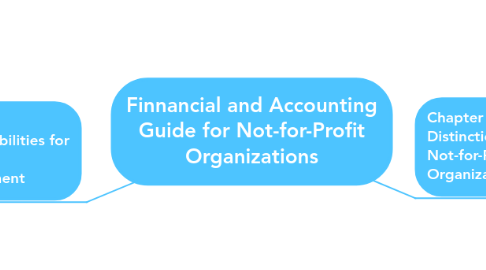
1. Chapter 1 Responsabilities for Fiscal Management
1.1. parts
1.1.1. Keeping Financial Records for the Organization
1.1.1.1. Treasurer
1.1.1.1.1. The treasurer is ultimately responsible for keeping realiable records. As such, detailed procedures are delegated to others.
1.1.2. Preparing Accurate and Meaningful Financial Statements
1.1.2.1. Treasurer
1.1.2.1.1. Is responsible to prepare complete and straightforward financial reports for management, for the board and for others, including regulatory authorities, who have an interest in the financial position and the financial activities of the organization.
1.1.3. Implementing a Budget and Anticipating Financial Problems
1.1.3.1. Treasurer
1.1.3.1.1. Is responsible for identifying financial trends and events. Furthermore, the treasurer will typically be responsible for explaining variances against the budget throughout the year.
1.1.4. Safeguarding Financial Assets and Providing Effective Internal Controls
1.1.4.1. Internal Control
1.1.4.1.1. An effective internal control environment provides for the prevention and timely detection of material errors, omissions, or irregularities in the normal course of operations.
1.1.4.1.2. Internal accounting controls involve delegating duties and recordkeeping functions
1.1.4.1.3. An effective internal control environment includes a series of processes and policies that serve to protect the organization.
1.1.4.2. Treasurer
1.1.4.2.1. Is responsible for providing physical safeguards to protect assets against unauthorized use or theft and to regularly evaluate the sufficiency of insurance coverage.
1.1.5. Complying with Federal and State Reporting and Regulatory Requirements
1.1.5.1. Treasurer
1.1.5.1.1. Is charged with compliance under the numerous federal and state reporting requirements
1.1.6. Communicating Fiscal Information to the Board of Directors and Audit Committee
1.1.6.1. Treasurer
1.1.6.1.1. Have a close relationship to the audit committee.
1.1.6.1.2. Help board members understandand interpret fiscal reports by communicating variances.
1.1.7. Ten Key Points to Consider in Not-for-Profit Fiscal Management
1.1.7.1. parts
1.1.7.1.1. Accounting Principles
1.1.7.1.2. Financial Reporting
1.1.7.1.3. Budgeting and Resources
1.1.7.1.4. Financial Management
1.1.7.1.5. Government Regulation
1.1.7.1.6. Contributions
2. Chapter 2 Accounting Distinctions between Not-for-Profit and Commercial Organizations
2.1. parts
2.1.1. Stewardship versus Profitability
2.1.1.1. diferences between
2.1.1.1.1. Commercial Organizations
2.1.1.1.2. One of the principal differences between not-for-profit and commercial organizations is that they have different reasons for their existence.
2.1.1.1.3. Not-for-profit Organizations
2.1.2. Principal Areas of Accounting Differences
2.1.2.1. There are seven areas where the accounting principles followed by not-forprofit organizations often differ, at least somewhat, from the accounting principles followed by commercial organizations.
2.1.2.1.1. There is an audit guide
2.1.2.2. parts
2.1.2.2.1. Cash versus Accrual Accounting
2.1.2.2.2. Fund Accounting
2.1.2.2.3. Transfers and Appropriations
2.1.2.2.4. Treatment of Fixed Assets
2.1.2.2.5. Contributions, Pledges, and Noncash Contributions
2.1.2.2.6. Accounting for Investments
2.1.2.2.7. Functional Reporting of Expenses

